Sports concussions: Coming to the right conclusions
To determine when an athlete with a head injury can safely return to play, you'll need to evaluate the blow's severity and identify residual symptoms. Concussions beyond the first call for special attention.
Sports concussions: Coming to the right conclusions
Cover Story
By Vito A. Perriello, Jr., MD, and Jeffrey T. Barth, PhD
To determine when an athlete with a head injury can safely return to play, you'll need to evaluate the severity of the blow and identify residual symptoms. Concussions beyond the first call for special attention.
LEARNING
OBJECTIVES
After reviewing this article
the physician should be able to:
Recognize the signs and symptoms of concussion incurred in sports.
Choose tools to evaluate residual signs and symptoms of brain injury too subtle to identify by the standard neurologic and mental status exam.
Identify the dangers of second impact syndrome, multiple concussions, and premature return to action after even minor head injury.
Predict when neuropsychologic testing or neuroimaging can be helpful in making return-to-play decisions.
Head trauma is common in sports. Each year, sports participants in the United States experience an estimated 300,000 mild to moderate head injuries that could be classified as concussions.1 The occasional death of an athlete who has returned to play after a mild head injury and receives a second injury, the so-called second-impact syndrome, highlights the need for information on when it is safe to return to practice and games after a concussion. Physicians whose patients are athletes, especially youngsters who participate in contact sports (Table 1), also are concerned about the possibility of permanent brain damage from the cumulative effects of multiple concussions.2 Young players, influenced by reports about "macho" professional athletes who return to play before their doctors advise them to, need to be helped to understand that they are more vulnerable to serious brain injury than their older, professional counterparts.
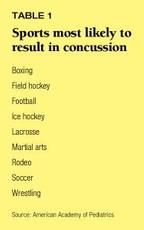
Many factors work against development of universally accepted guidelines for managing athletes with concussions. The lack of a uniform grading system for concussions, for example, makes it difficult to compare studies and analyze data. Other impediments include the absence of a practical way to determine an athlete's post-concussion status, lack of consensus on what constitutes "too many" concussions, and extreme diversity in the criteria used by those who make "return to action" decisions. A recent study even calls into question the importance of loss of consciousness as a prognostic factor.3 Underscoring these handicaps is our lack of knowledge about the pathobiology and pathophysiology of what is happening inside the brain when the head is injured during sports. Several medical and sports organizations and individual investigators are addressing these issues.4,5
In the meantime, pediatricians need to rely on the standard neurologic and mental status examinations with which they are familiar and be knowledgeable about newer sports-specific tests for judging an athlete's post-concussion status. In addition to describing these tools, we offer several algorithms for deciding when it is safe for the athlete with a head injury to return to play. Although pediatricians rarely are on hand to make instant "sideline" decisions when a youngster is injured during a game, they may be asked to do a follow-up evaluation. They can also help educate families, coaches, and others in the community about prevention and other issues.
The sideline evaluation
In a concussion, a person's mental status is temporarily altered as a result of head trauma. During a game or practice, any youngster who becomes dazed or confused or who behaves in an unusual or inappropriate manner is considered to have suffered a concussion, whether or not he or she loses consciousness. Head injuries in sports are usually caused by direct impact, acceleration-deceleration injury, or glancing blows leading to rotational injury, which can create shearing forces of white matter tracts and diffuse axonal injury. The individual who has a concussion may have deficits in mental status, coordination, focus, speed of processing information, or memory.
Coaches, athletic trainers, and other adults who make sideline decisions about when and if to return an athlete with a head injury to the game need a relatively straightforward plan to follow. Although several concussion grading systems, listed in Table 2, have evolved over the years, no one of them has been adopted.6 The user-friendly system developed recently by the American Academy of Neurology provides a practical approach to making sideline decisions.7 This system, along with management and return-to-play criteria, is concisely described on a laminated card (see "Resources to guide sideline decisions.").
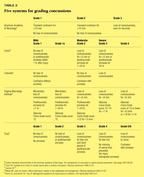
Resources to guide sideline decisions
The availability of a laminated card and a brochure with key information for making sideline decisions about athletes with concussion is a boon for coaches and athletic trainers, as well as pediatricians.
Laminated card. Prepared by the American Academy of Neurology and the Brain Injury Association, the card includes definitions of the grades of concussion, management recommendations, and criteria for making return to play decisions, based on concussion grade. It also lists common signs and symptoms of concussion and some simple tests for evaluating mental status and neurologic state. To order cards, call 800-321-7037.
Brochure. More detailed than the card, the brochure describes the signs of concussion and guidelines for sideline management, including an algorithm for determining if it is safe for a player with a mild concussion to return to the game. The brochure, which is distributed through the National Federation of State High School Associations, is available from the association at 317-972-6900. It also can be downloaded from its Web site: www.nfhs.org.
The office evaluation
The off-the-field evaluation of a child who has had a concussion begins with observation for classic signs and symptoms of concussion and testing for deficits in cognition, mental status, and coordination (Table 3). Some of these tests will also have been performed right after the injury; others are not appropriate for sideline assessment. These objective tools may detect significant but subtle abnormalities that would be missed if the evaluation relied on subjective impressions or responses from the athlete, who may deny symptoms. Other instruments being tested, described in "New tools in the pipeline," may make it possible to develop objective guidelines for determining when athletes should return to participation in a sport following one or more concussions.
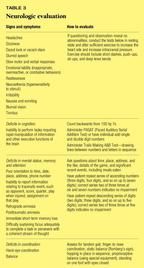
New tools in the pipeline
At many athletic contests and practices, individuals making the decision to return concussed athletes to the game do not have the medical training and knowledge for this determination. In addition, they, and physicians who examine the athlete later in an office, often are subject to significant pressure to return a valuable athlete to action. In response to these difficulties, research is underway to develop objective and practical instruments to identify residual deficits that may not be obvious from the traditional on- and off-the-field evaluation.
Sideline assessment. Several groups are developing sideline assessment instruments to help those who must decide whether an athlete is "recovered" enough to return to a game after a head injury. These instruments may be most helpful when there are no obvious abnormal findings since it already is accepted that an athlete with any obvious post-concussive effects should not return to play.
The Sideline Concussion ChecklistB (SCC) is being field tested on athletes.8 The checklist calls for repeated neurocognitive exams at 10- to 15-minute intervals. Physical signs, such as pupil inequality, dysmetria, diplopia, and tandem gait, are part of the examination, as is a deterioration in test performance after exercise. Symptoms such as vomiting, headache, dizziness, and nausea are also scored. Neuropsychologic measurements such as orientation to facts about the game, attention, short-term memory, and digit span forward and backward, cognitive abilities, and remote memory are examined. Although the checklist is not intended to be the sole basis for return to play, it does provide an assessment template to ensure attention to relevant neurologic systems.
Neuropsychologic testing. Since a full neuropsychologic battery is too long for widespread use, neuropsychologists are developing a brief neurocognitive test that can be used as one station in the school-based preparticipation physical examination or in the offices of pediatricians who have been trained in administering it.9 Preliminary studies suggest that some of the items in this test can differentiate the athlete who has had a concussion from one who has not, perhaps eventually even without preconcussion baseline data. This instrument can identify deficits that persist after the obvious signs of concussion are gonedeficits that appear to be relevant in determining whether a athlete can safely return to the game.
Neuroradiologic studies. Neuroradiology may have a significant role in discerning the chronic effects of multiple concussions, though neuropsychologic testing appears to be more sensitive. Abnormal findings on MRI or CT probably are not apparent until very late stages of recurrent or chronic head injury (when diffuse generalized atrophy and dilated ventricles can be seen); by this time, cognitive deficits are already observable. Positron emission tomography scans have revealed the metabolic dysfunction associated with second impact syndrome. Likewise, MRIs obtained in conjunction with various sensory stimuli (functional MRIs) are being tested in patients with mild and moderate head injury and may help correlate dysfunction with lesion sites by showing alterations in the neurobiochemistry of the brain.
All tests should be performed both in the resting state and after sufficient exercise to raise the heart rate and increase intracranial pressure. Appropriate exercise includes short sprints (probably not practical in the office) and five to 10 push-ups, sit-ups, and knee bends. These tests should be used in conjunction with consideration of the severity and nature of the injury, the interval since the last head injury, the level of play, and the clinical judgment of the examiner.
The use of X-ray, magnetic resonance imaging (MRI), and computed tomography (CT) studies in acute head trauma was controversial even before managed care put an emphasis on cost containment. In general, these studies are indicated only if an injury does not resolve in the usual manner or if the nature of the injury or physical findings suggests the need for imaging. Persistence of residual symptoms more than one week after injury or abnormal neurologic findings might suggest such a need, for example.
Deficits in cognition. Counting backwards from 100 by 7 is a standard test; however, many youngsters have trouble doing this even without head trauma. Neuropsychologic tests, such as the the Paced Auditory Serial Addition Test (PASAT), are useful for pre- and post-injury assessment to document rapid, complex problem-solving ability; the athlete listens to an audiotape of single-digit numbers and performs mental calculations. The Trails Making A & B is another useful neuropsychologic test for evaluating attention and complex problem solving.10 It asks the athlete to draw lines connecting circled numbers and letters. Like the PASAT, the test can be performed 24 to 48 hours after injury. With some training, the pediatrician can conduct the PASAT and Trails Making A&B test, though it is ideal to consult a neuropsychologist. Test outcomes, especially with regard to tasks requiring cognitive manipulation of information, are best understood in relation to preseason baseline assessment, particularly if the outcomes are to be used as part of the return-to-play evaluation. Consequently, it's a good idea to consider getting baseline scores for some of the tests described above or in the next section in the preparticipation examination.
Deficits in mental status, memory, and attention. Asking the youngster to repeat a series of digits forward and backward and name the months backward is a reasonable and quick way to evaluate attention. Most high school athletes should be able to repeat about seven numbers forward and five numbers backward two out of three times. When calling out the numbers, present them at one-second intervals in a monotone, without inflection.
Amnesia surrounding a concussion most often concerns the event itself. Asking the athlete the name of the opponent, the score of the game, the quarter in which the injury occurred, the play that was called in the huddle, the athlete's assignment on that play, and the sequence of events that led to the injury tends to be most helpful in evaluating the mental status of the injured youngster. It is less commonand somewhat more concerning if the youngster has forgotten the events that preceded the injury rather than the event itself (retrograde amnesia). Asking him what he did and what conversations he had in the hours before the injury is a meaningful way to assess his mental status; it also is worth checking that the athlete knows the time, date, his address, and his phone number. Asking the youngster to memorize and minutes later to recall three to five words also will give some measure of immediate recall memory and cerebral functioning.
Deficits in coordination. The standard neurologic maneuvers, such as finger-to-nose testing and checking tandem gait and static balance (Romberg's sign) should be part of the central nervous system evaluation, but asking a youngster to hop in place three times on the left foot and two times on the right foot, for example, requires greater balance and attention. Standing on one foot with eyes open and then closed for 10 seconds is a reasonable test for vestibular integrity. If the patient shows no residual signs or symptoms of concussion but you suspect proprioceptive deficits deficits in receiving stimuli within the muscles and tendonsrefer him or her to a sports medicine center that has special equipment for testing for these deficits.11
Second impact syndrome
In determining whether the child who has had a concussion can safely return to play, keep in mind the second impact syndrome, a rare but catastrophic event. Even a "mild" concussion with no loss of consciousness can be potentially damaging. In second impact syndrome the patient dies or suffers permanent brain damage after a blow to the head that occurs while brain cells are still "injured" from a previous traumatic brain injury.12,13 The blows in either injury can appear to be fairly mild. Why certain individuals are susceptible to this type of damage is uncertain.
The devastating effects of the second impact syndrome appear to be related to an imbalance between fuel needs and fuel delivery. The brain apparently needs additional glucose after injury (hyperglycolosis) because of an increase in Na+/K+ pump activity. The decrease in cerebral blood flow appears to be related to vasoconstriction and is associated with increased endothelial concentrations of Ca++. It is believed that the increased glucose demands and decreased cerebral blood flow that follow a traumatic head injury can damage some neurons irreversibly and leave many more brain cells alive but vulnerable. These metabolically dysfunctional neurons cannot survive even the minimal decrease in cerebral blood flow and increase in glucose demands that accompany a mild subsequent injury.
We have few objective neuroanatomic or metabolic barometers to measure the existence and duration of post-concussion vulnerability. Cerebral hyperglycolysis, which contributes to brain cell vulnerability, has been observed for as long as two weeks after head injury. The immature brain of youngsters appears to be vulnerable to these effects for longer than the brain of adults. Consequently, the younger the injured child, the less quickly the physician should return her to play.
Answering the key questions
Three key questions arise about athletes who have had concussions.
When is it safe for an athlete who has had a head injury to go back into the game in which the injury occurred? According to the algorithm in Figure 1, developed by the National Federation of State High School Associations and its medical advisory committee, only the child who receives a "ding" whose associated confusion "clears" rapidly is allowed to return to play in that game or practice.5 All others, as well as the child who loses consciousness, even if only for seconds, are prohibited from play and must have medical clearance before participating in the sport again. A history of previous head injury also should be considered in making the return to play decision.
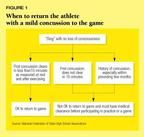
When can an athlete who is removed from a game because of a head injury resume participation in the sport? In a typical scenario, the injured athlete reports to the physician for medical clearance saying that she or he feels fine. The classic neurologic exam is normal, and the youngster is oriented to time and place. At this point the pediatrician should assess the patient for residual symptoms or deficits in memory, attention, focus, cognitive skills, and coordination. If the athlete has no residual symptoms or deficits, even after exercise, she or he can begin playing again one week after the injury or the last documented symptom, whichever is later. If the physician finds or suspects residual deficits, referral for comprehensive neuropsychologic testing and neuroradiologic imaging should be considered. The algorithm in Figure 2 presents a comprehensive management plan for the child who has had a head injury.14
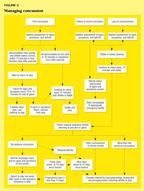
How many concussions are too many to recommend ongoing participation in a contact sport? One of the goals in managing head injuries is to prevent brain damage associated with cumulative effects of multiple head injuries. By the time we see the physical signs of dementia pugilistica in boxers or the radiographic findings of wide septum pellucidum (diffuse atrophy and dilated ventricles), much of the damage is done.15,16 A recent study suggests that deficiencies in attention and concentration may persist for up to three months in an individual who has more than one concussion in a month and longer in patients with more than one previous brain trauma.17 Other investigations show that neuropsychologic scores can drop after even a mild head injury and that memory deficits may persist for 10 days after injury.5, 18,19 Attention and concentration appear to be the last parameters to normalize.20 To have the best chance of preventing cumulative effects of multiple head injuries, we suggest considering referral for neuropsychologic testing and neuroimaging for the child with one recent concussion in addition to the present one or with two or more previous concussions.
Preventing head injuries
Using appropriate headgear that is in good repair and fits properly and enforcing rules against practices known to be dangerous, such as spearing in football (Figure 3), can reduce catastrophic injuries dramatically.10,20,21 Pediatricians should inform supervisors of school and community athletic programs about prevention and address it in their anticipatory guidance. Parents also need guidance on the importance of using protective gear in noncontact sports associated with concussions, such as bicycling. Evidence of the effectiveness of helmets in preventing head injuries in bike riders is overwhelming.22 Youngsters who skateboard, rollerblade, snowboard, or ski also need proper protective equipment. Recent research indicates that heading the ball in soccer also is associated with evidence of neurocognitive damage, particularly impairment in memory and planning functions.23 Further study is needed before any firm conclusions can be drawn from these findings.

Putting it together
The risk of injury, including concussion, is inherent to contact sports. The goal of coaches, trainers, and pediatricians is to minimize, if not eliminate, the catastrophic injuries that may ensue when a concussed athlete returns to action too soon or has "too many" head injuries. Everyone agrees that the injured athlete should not return to play until all postconcussion signs and symptoms have cleared. Agreement breaks down, however, when it comes to defining what constitutes clinical or laboratory normalcy. Nonetheless, pediatricians should feel comfortable about recommending return to play after a concussion if the athlete is neurologically normal, has no residual symptoms, and has not had a recent prior concussion. Referral for costly imaging studies and extensive neuropsychologic testing should be necessary only for a youngster with abnormal neurologic findings, a slowly clearing concussion, or a history of multiple previous concussions.
REFERENCES
1. Sports-related recurrent brain injuries. MMWR 1997;46(10):224
2. American Academy of Pediatrics Committee on Sports: Recommendations for participation in competitive sports. Pediatrics 1988;81:5
3. Lovell MR, Iverson GL, Collins MW, et al: Does loss of consciousness predict neuropsychological decrements after concussion? Clin J Sports Med 1999;9:193
4. McCrea M, Kelly JP, et al: Standardized assessment of concussion in football players. Neurology 1997;48:586
5. Perriello V: Suggested Guidelines for Management of Head Trauma in Sports. Kansas City, MO, NFHS Publications, 1998
6. Collins MW, Lovell MR, McKeag DB: Current issues in managing sports-related concussion. JAMA 1999; 282:2283
7. Quality Standards Subcommittee of the American Academy of Neurology: The management of concussion in sports. Neurology 1997;48:581
8. Kutner KC, Varth JT: Sport related head injury. The Bulletin (National Academy of Neuropsychology) 1998
9. Perriello VA: Virginia's athletic exam form: Results and revisions. Virginia Medical Quarterly 1992;119:159
10. Lezak M: Neuropsychological Assessments. New York, NY, Oxford University Press, 1994
11. Guskiewicz K, Riemann BL, Perrin DH, et al: Abnormal balance persists after head injury. Medicine and Science in Sports and Exercise 1997;suppl 7:S213
12. Cantu RC, Voy R: Second impact syndrome: A risk in any contact sport. Physicians and Sports Medicine 1995;23:27
13. Wojtys E: Concussion in sports. Am J Sports Med 2000;27(5):676
14. Barth JT, Alves W, Ryan TV, et al: Mild head trauma in sports: Neuropsychological sequelae and recovery of function, in Lev JS, Eisenberg HM, Benton AL (eds): Mild Head Injury. New York, NY, Oxford University Press, 1989, p 257
15. Millspaugh JA: Dementia pugilistica. US Navy Med Bull 1937 35:297
16. Casson HR, Siegel O, Sham R, et al: Brain damage in modern boxers. JAMA 1984;231:2663
17. Carlson GS, Svardsood K, Welm L: Long-term effects of head injury sustained during life in three male populations J Neurosurg 1987;67:197
18. Wilberger JF: Minor head injuries in American football: Prevention of long-term sequelae. Sports Med 1993;15:338
19. Barth JT, Macciocchi SN, Boll TJ, et al: Neuropsychological sequelae of minor head injury. Neurosurgery 1983;13:529
20. Alves WM: Football induced mild head injury, in Torg JS (ed): Athletic Injuries of the Head, Neck and Face. St. Louis, MO, Mosby Year Book, 1991, p 28
21. Cantu RC, Mueller PD: Catastrophic injuries in high school and college sports, 19821997. Physicians and Sports Medicine 2000;27:35
22. Mumper EA, Brennan TL: Hats off to helmets! Contemporary Pediatrics 1997;14(10):123
23. Matser EJ, Kessels AG, Lezak MD, et al: Neuropsychological impairment in amateur soccer players. JAMA 2000;282:971

ACCREDITATION
This activity has been planned and implemented in accordance with the Essentials and Standards of the Accreditation Council for Continuing Medical Education through the joint sponsorship of Jefferson Medical College and Medical Economics, Inc.
Jefferson Medical College of Thomas Jefferson University, as a member of the Consortium for Academic Continuing Medical Education, is accredited by the Accreditation Council for Continuing Medical Education to sponsor continuing medical education for physicians. All faculty/authors participating in continuing medical education activities sponsored by Jefferson Medical College are expected to disclose to the activity audience any real or apparent conflict(s) of interest related to the content of their article(s). Full disclosure of these relationships, if any, appears with the author affiliations on page 1 of the article.
CONTINUING MEDICAL EDUCATION CREDIT
This CME activity is designed for practicing pediatricians and other health-care professionals as a review of the latest information in the field. Its goal is to increase participants' ability to prevent, diagnose, and treat important pediatric problems.
Jefferson Medical College designates this continuing medical educational activity for a maximum of one hour of Category 1 credit towards the Physician's Recognition Award (PRA) of the American Medical Association. Each physician should claim only those hours of credit that he/she actually spent in the educational activity.
This credit is available for the period of February 15, 2000, to February 15, 2001. Forms received after February 15, 2001, cannot be processed.
Although forms will be processed when received, certificates for CME credits will be issued every four months, in March, July, and November. Interim requests for certificates can be made by contacting the Jefferson Office of Continuing Medical Education at 215-955-6992.
HOW TO APPLY FOR CME CREDIT
1. Each CME article is prefaced by learning objectives for participants to use to determine if the article relates to their individual learning needs.
2. Read the article carefully, paying particular attention to the tables and other illustrative materials.
3. Complete the CME Registration and Evaluation Form below. Type or print your full name and address in the space provided, and provide an evaluation of the activity as requested. In order for the form to be processed, all information must be complete and legible.
4. Send the completed form, with $20 payment if required (see Payment, below), to:
Office of Continuing Medical Education/JMC
Jefferson Alumni Hall
1020 Locust Street, Suite M32
Philadelphia, PA 19107-6799
5. Be sure to mail the Registration and Evaluation Form on or before February 15, 2001. After that date, this article will no longer be designated for credit and forms cannot be processed.
FACULTY DISCLOSURES
Jefferson Medical College, in accordance with accreditation requirements, asks the authors of CME articles to disclose any affiliations or financial interests they may have in any organization that may have an interest in any part of their article. The following information was received from the authors of "Sports concussions: Coming to the right conclusions":
Vito A. Perriello, Jr., MD, has no information to disclose.
Jeffrey T. Barth, PhD, has no information to disclose.
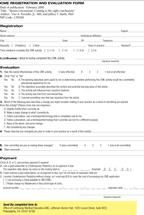
DR. PERRIELLO is Clinical Assistant Professor of Pediatrics, University of Virginia School of Medicine, Charlottesville, where he is in private pediatric practice.
DR. BARTH is Professor, Psychiatric Medicine/ Neurosurgery, University of Virginia School of Medicine, Charlottesville.
Vito Perriello,Jeffrey Barth. Sports concussions: Coming to the right conclusions. Contemporary Pediatrics 2000;2:132.